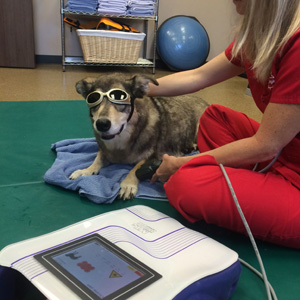Therapeutic laser treatments
 LASER stands for light amplification by stimulated emission of radiation (emits radiation in the form of a flow of photons). Laser light contains one wavelength of color and travels in a straight line so that it can penetrate the surface of the skin with no heating effect and no damage to the skin. Low level laser supplies energy to the body in the form of photons. Photons are released when electrons change orbits and they trigger biologic changes within the body. Laser therapy has been shown to increase growth factor response within cells and tissue as a result of increased ATP and protein synthesis. Accelerated cell reproduction and growth leads to faster repair of damaged tissues. Therapeutic lasers also have anti-inflammatory effects and promote faster wound healing. Laser treatments are painless, quick, and do not interact with any other medications.
LASER stands for light amplification by stimulated emission of radiation (emits radiation in the form of a flow of photons). Laser light contains one wavelength of color and travels in a straight line so that it can penetrate the surface of the skin with no heating effect and no damage to the skin. Low level laser supplies energy to the body in the form of photons. Photons are released when electrons change orbits and they trigger biologic changes within the body. Laser therapy has been shown to increase growth factor response within cells and tissue as a result of increased ATP and protein synthesis. Accelerated cell reproduction and growth leads to faster repair of damaged tissues. Therapeutic lasers also have anti-inflammatory effects and promote faster wound healing. Laser treatments are painless, quick, and do not interact with any other medications.
Lasers are frequently used to treat:
- Arthritis/DJD
- Muscle, ligament, and tendon injuries
- Sprains and strain
- Ulcerations and open wounds
- Post surgical and soft tissue trauma
